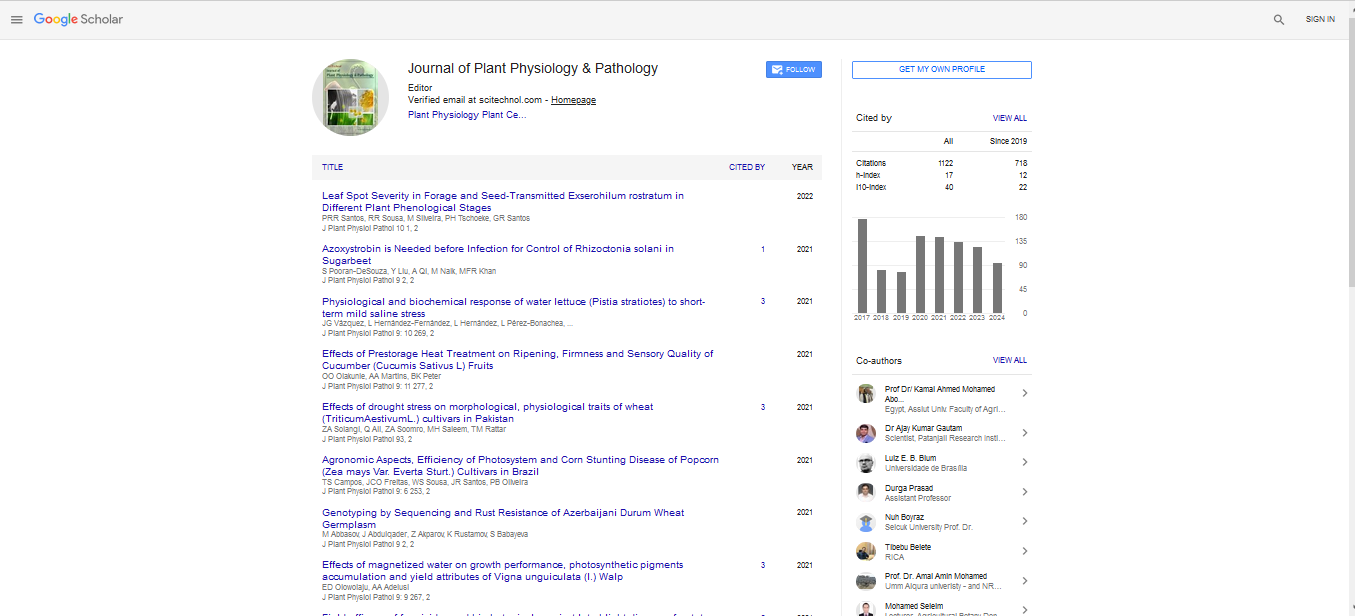Evidence for different water use strategies by analyzing leaf performance between two wheat seedling cultivars under PEG-6000 treatment
Ilva Licaj
University of Sannio, Italy
: J Plant Physiol Pathol
Abstract
Considering global climate change, drought is the major constraint to crops cultivation, leading to reduced yields and quality. Since the wheat is among the most widespread grain crops, its cultivation is fundamental for staple human and animal nutrition. Based on that, our objective was to recognize the diverse stress-responsive strategy of the ancient wheat seedlings cultivar Saragolla and the modern one Svevo under drought stress. We used anatomical, morphological and physiological analyses by investigating changes in the foliar performance underpinning drought resistance. Seedlings were subjected to normal water condition and water restriction (using PEG-6000 treatment). We aimed to understand how different concentrations of foliar calcium can confer drought stress tolerance; given that Ca2+ is an important signaling molecule even in response to drought stress. According to the images acquired from the confocal laser scanning microscopy to detect and record Ca2+ signaling in leaf cells of the Saragolla and Svevo wheat under normal drought condition, we estimated that Ca2+, in turn, seemed to regulate transcriptionally the genes (MAPK3/6, ERF109, MYB60, TaTCP1) triggered by osmotic stress and involved in cellular functions ranging from developmental processes to abiotic stress responses. Subsequently, we revealed that the ancient wheat seedlings cope greater with drought stress by exhibiting higher water retention capability, greater stomatal opening degree, the widest xylem vessels and well-compacted mesophyll cells, reduced stomatal density, a spontaneous faint moderate Ca2+ fluorescence compared to the other cultivar, which, in turn maintained lower chlorophyll content by affecting more negatively the photosynthetic rate. Consequently, these results suggest that the Saragolla wheat which manifested better leaf plasticity may have a higher potential to survive prolonged water stress than the Svevo. Recent Publications: 1. Dunn J, Hunt L, Afsharinafar M, Meselmani MA, Mitchell A, Howells R, Gray JE. Reduced stomatal density in bread wheat leads to increased water-use efficiency. Journal of Experimental Botany (2019). 2. He X, Xu L, Pan C, Gong C, Wang Y, Liu X, Yu Y. Drought resistance of Camellia oleifera under drought stress: Changes in physiology and growth characteristics. Soil Sciences (2022). 3. Jing X, Cai C, Fan S, Luo H. Physiological Response Characteristics of Moso Bamboo under Drought Stress Based on Calcium Signal. Forests (2021).
Biography
Ilva Licaj has her expertise in plant physiology to provide new insights for great drought responses in plants, by following morphological, anatomical, physiological, biochemical, and molecular approaches. Recently she tends to have in focus crop cultivars, since drought as one of the most common and challenging abiotic stresses experienced by plants and the main limiting factor for agricultural productivity, can reduce crop yields and quality resulting in a huge impact on the economy worldwide. For that reason, her expertise can provide theoretical basis for improving wheat tolerance to more unstable climates for a sustainable agriculture.
 Spanish
Spanish  Chinese
Chinese  Russian
Russian  German
German  French
French  Japanese
Japanese  Portuguese
Portuguese  Hindi
Hindi 
